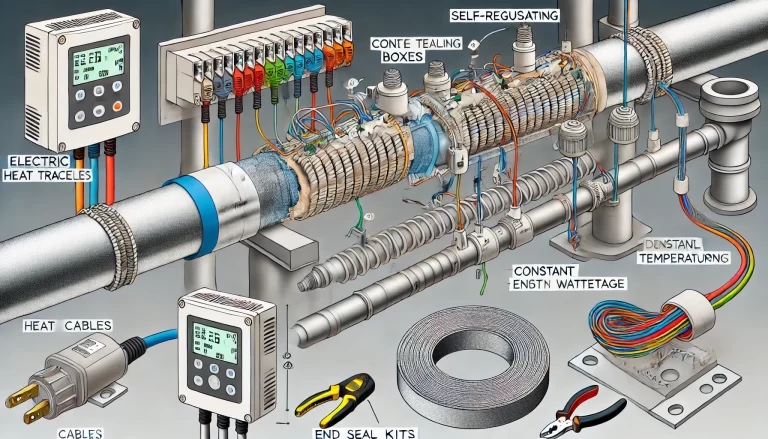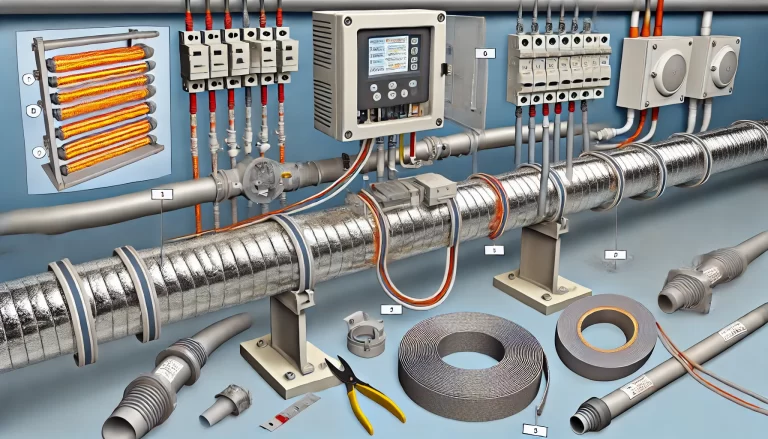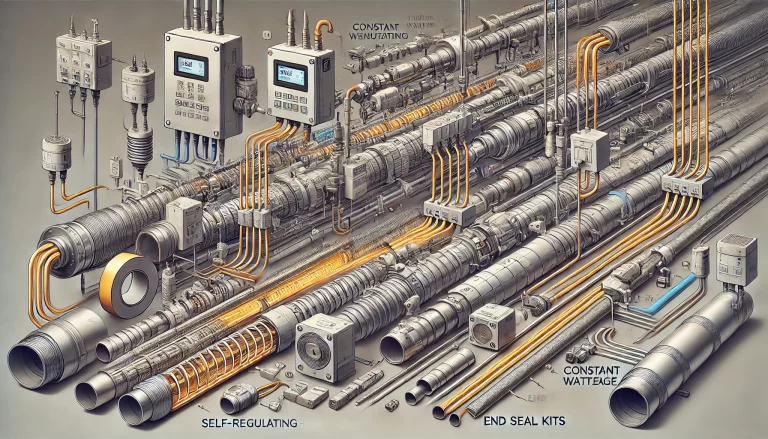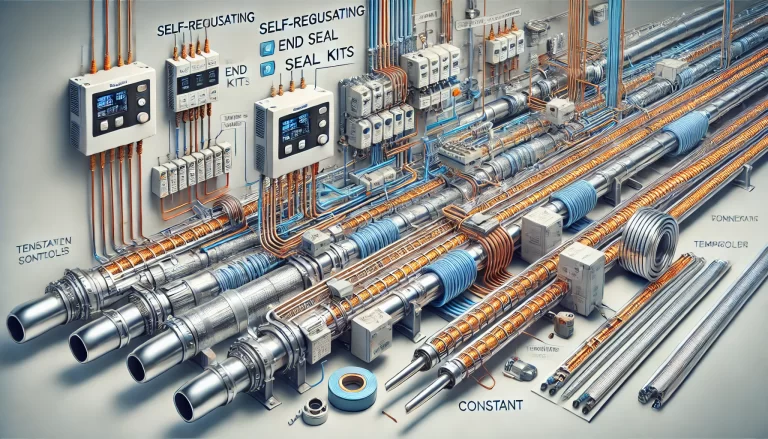Electric heat trace systems are essential in various industries to maintain the temperature of pipes, tanks, or equipment. They prevent the freezing of liquids or ensure materials remain at optimal flowable conditions, especially in cold environments. Below is a detailed explanation of the main components that make up an electric heat trace system.
1. Heating Cables / Heat Trace Cables
The heating cable is the backbone of an electric heat trace system. Different types of cables suit various applications:
Self-regulating Heating Cable:
This cable adjusts its power output based on the surrounding temperature. It reduces power consumption as temperatures rise, preventing overheating and improving energy efficiency. It is ideal for pipes and equipment with variable temperature needs.Constant Wattage Heating Cable:
This type provides a fixed power output regardless of temperature changes. It ensures steady heating and is suitable for longer pipelines that require continuous heat maintenance.Mineral Insulated (MI) Heating Cable:
MI cables consist of a metal sheath and magnesium oxide insulation, making them robust and suitable for high-temperature applications and harsh environments like refineries or chemical plants.

2. Temperature Controllers and Control Systems
These components regulate the temperature of the system to ensure consistent heating.
Mechanical Thermostats:
Mechanical thermostats are simple devices that switch the heating cable on or off based on preset temperature thresholds. They are cost-effective but less precise than digital controllers.Electronic Temperature Controllers:
These controllers offer more precise temperature control through analog or digital interfaces. They allow for customized temperature settings and are often used in applications that require precise thermal management.Advanced Control Systems:
These systems use programmable logic controllers (PLCs) or remote monitoring tools to manage the heat trace network. They can adjust power output, log temperature data, and raise alarms in case of malfunctions, improving overall system reliability.
3. Connection and Junction Components
To ensure seamless installation and performance, reliable connections are essential.
Connection Boxes / Junction Boxes:
These waterproof boxes house the connections between heating cables and the power supply, protecting the system from external elements such as water or dust.Intermediate Splice Kits:
These kits enable the connection of multiple cable sections, ensuring the heat trace can be extended along long pipelines.End Seal Kits:
End seals protect the cable terminations from moisture ingress and electrical faults, maintaining the system’s integrity and safety.
4. Fixing and Mounting Accessories
These accessories ensure that the heating cables stay securely attached to the pipes or surfaces.
Cable Ties and Clips:
These are used to fasten heating cables to pipes, ensuring consistent contact and preventing movement that could affect performance.Aluminum Tape:
Aluminum tape improves heat distribution by securing the heating cable along surfaces and enhancing heat transfer.

5. Insulation and Protective Covering
Proper insulation helps minimize heat loss, ensuring the efficiency of the heat trace system.
Thermal Insulation Materials:
Materials like fiberglass, rock wool, or polyurethane are used to insulate the pipe or equipment, reducing energy consumption by minimizing heat loss.Outer Cladding / Protective Covering:
PVC jackets or metal cladding protect the insulation layer from environmental exposure, preventing damage from moisture or UV rays.
6. Power Supply and Distribution Systems
The heat trace system requires an appropriate electrical supply to operate safely and efficiently.
Power Supply Lines:
These cables connect the heating system to a power source, typically ensuring the system operates at 120V, 240V, or other required voltages.Distribution Panels and Circuit Breakers:
Distribution panels manage the electricity flow to multiple heating cables, while circuit breakers provide overload and short-circuit protection.
7. Safety and Alarm Systems
Safety mechanisms ensure that the heat trace system operates reliably and alerts operators to any issues.
Ground Fault Circuit Interrupters (GFCIs):
GFCIs detect any leakage currents and shut down the system to prevent electrical hazards like shocks or fires.Alarm Systems:
Alarms alert operators to temperature deviations, power loss, or electrical faults, allowing for timely corrective actions and reducing downtime.

8. Monitoring Systems (Optional)
In advanced systems, monitoring ensures optimal performance and preventive maintenance.
Temperature Sensors:
Sensors placed along the pipe or tank monitor temperature in real time and send data to controllers to maintain the desired heat levels.Flow and Pressure Sensors:
For pipelines, flow and pressure sensors detect any changes in the medium being transported, ensuring the heat trace system functions efficiently to avoid freezing or blockages.
Applications of Electric Heat Trace Systems
Electric heat trace systems are widely used across industries:
- Oil and Gas Industry: Maintaining the flow of crude oil, natural gas, or chemical substances in pipelines.
- Chemical Plants: Preventing crystallization or solidification of chemical agents during storage or transport.
- Food and Beverage: Ensuring liquid food products stay at a specific temperature during processing.
- Water Supply Systems: Preventing water pipes from freezing in cold climates.
- Buildings and Infrastructure: Melting snow on roofs, sidewalks, or ramps to prevent accidents.

Conclusion
An electric heat trace system is essential for maintaining optimal temperatures in various industrial and commercial applications. Its components work together to ensure safe, efficient, and reliable operations, preventing freezing, minimizing energy loss, and ensuring smooth processes even in harsh environments. Understanding each part of the system helps in its proper design, installation, and maintenance, maximizing its benefits and extending its lifespan.
